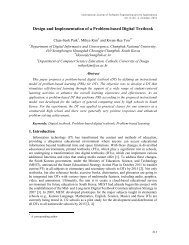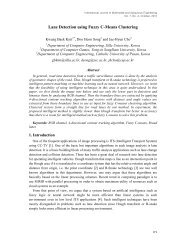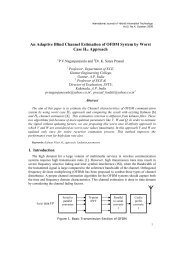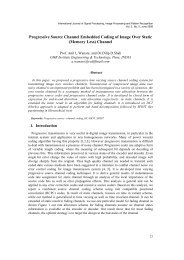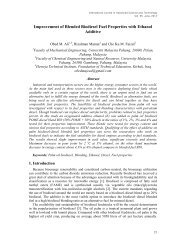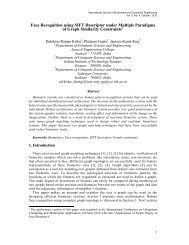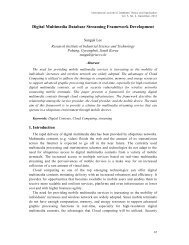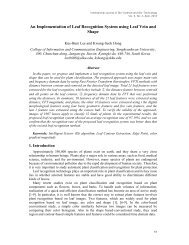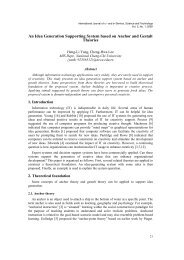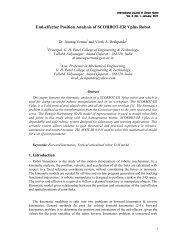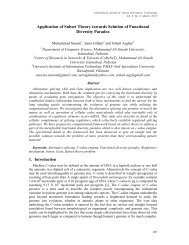A Communication Protocol of RFID Systems in Internet of Things
A Communication Protocol of RFID Systems in Internet of Things
A Communication Protocol of RFID Systems in Internet of Things
You also want an ePaper? Increase the reach of your titles
YUMPU automatically turns print PDFs into web optimized ePapers that Google loves.
International Journal <strong>of</strong> Security and Its Applications<br />
Vol. 6, No. 2, April, 2012<br />
2. Or r has already been <strong>in</strong>quired by Oracle Execute, CorruptRead, SendReader and<br />
'<br />
Test ( ) . We suppose it <strong>in</strong>quired q times before and now <strong>in</strong>quires q times, then the<br />
Ri<br />
'<br />
q<br />
possibility the attacker have right conjectures is no more than<br />
q .<br />
3. Or the attacker successfully calculates EPCR i<br />
that the length <strong>of</strong> EPCR i<br />
is l<br />
2<br />
, the<br />
probability for attack<strong>in</strong>g successfully is<br />
In all,<br />
1<br />
.<br />
2<br />
2 l<br />
'<br />
qsend<br />
qexe<br />
q 1<br />
Pr[ t H( EPCR<br />
) r] Pr[Adv(R)] Pr[ ] ,<br />
i<br />
l1 l2<br />
2 q 2<br />
'<br />
qsend<br />
qexe<br />
q 1<br />
( K) Pr[ ], So the proposition is proved.<br />
l1 l2<br />
2 q 2<br />
(2)Identity authentication <strong>of</strong> the tag<br />
Proposition2. If the symmetric encryption is secure, any attacker T <strong>of</strong> PPT types<br />
successfully calculates the probability <strong>of</strong> a H( E ( EPCT<br />
) r)<br />
to meet<br />
K ij T j<br />
K ij j<br />
Pr[ a H( E ( EPC ) r)] ( K)<br />
, it achieve identity authentication <strong>of</strong> the reader.<br />
Pro<strong>of</strong>.The event that the attacker can calculate<br />
K ij T j<br />
a H( E ( EPC ) r)<br />
without know<strong>in</strong>g<br />
K ij T j<br />
E ( EPC ) and r is recorded as Adv( T ) , it has the follow<strong>in</strong>g three possible:<br />
1. the a maybe known by the attacker T itself by <strong>in</strong>quir<strong>in</strong>g Oracles SendReader,<br />
Execute, CorruptRead and Test ( <br />
T<br />
) ,We suppose it had <strong>in</strong>quired q<br />
j<br />
send<br />
times by Oracle<br />
SendTag ( <br />
T<br />
, Pm ,<br />
1)<br />
, q<br />
j<br />
exe<br />
times by Oracle Execute ( R <br />
T<br />
, P)<br />
.And output length <strong>of</strong> H (.) is<br />
i j<br />
l . Accord<strong>in</strong>g to the characteristics <strong>of</strong> birth attack<strong>in</strong>g[11] ,the possibility the attacker<br />
1<br />
has the right conjectures is no more than<br />
q<br />
q<br />
send<br />
l<br />
2 1<br />
2. Or r has already been <strong>in</strong>quired by Oracle Execute, CorruptRead, SendReader and<br />
'<br />
Test ( ). We suppose it <strong>in</strong>quired q times before and now <strong>in</strong>quires q times, then the<br />
Tj<br />
possibility the attacker have right conjectures is no more than<br />
3. Or the attacker can E ( EPC<br />
T<br />
), because the symmetric encryption is secure, so the<br />
K ij j<br />
probability <strong>of</strong> successfully calculat<strong>in</strong>g<br />
So<br />
K ij T j<br />
exe<br />
.<br />
E ( EPC ) is neglected.<br />
'<br />
qsend<br />
qexe<br />
q<br />
Pr[ a H( EK<br />
( EPCT<br />
) r)] Pr[Adv(T)] Pr[ ] ,<br />
ij<br />
j<br />
l1<br />
2 q<br />
'<br />
qsend<br />
qexe<br />
q<br />
( K) Pr[ ] , proposition is pro<strong>of</strong>.<br />
l1<br />
2 q<br />
Theorem 2.If the symmetrical encryption is secure, SPAP can achieve forward<br />
security.<br />
'<br />
q<br />
q .<br />
98



